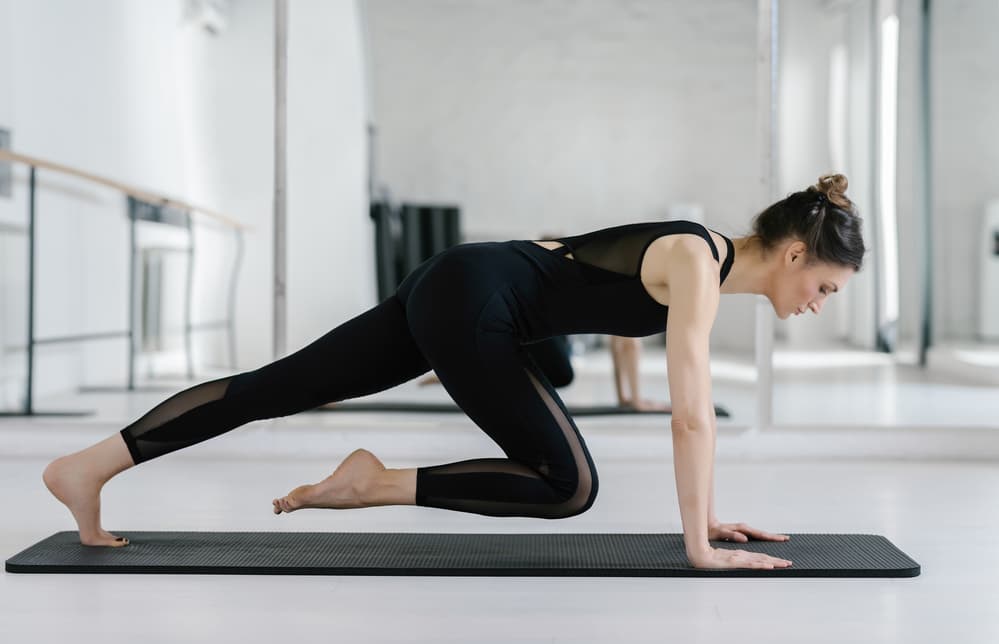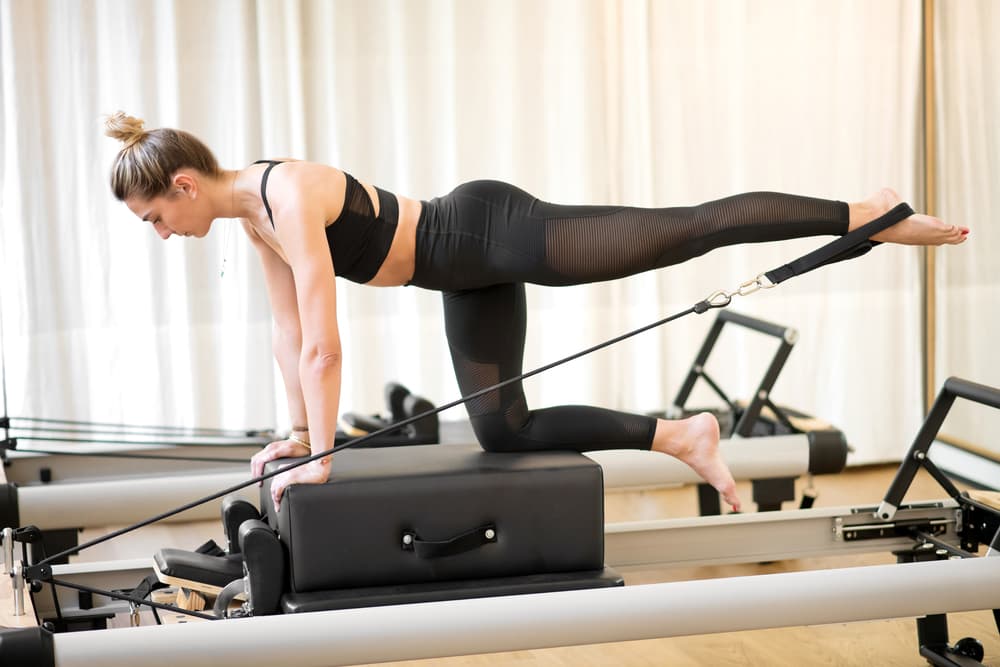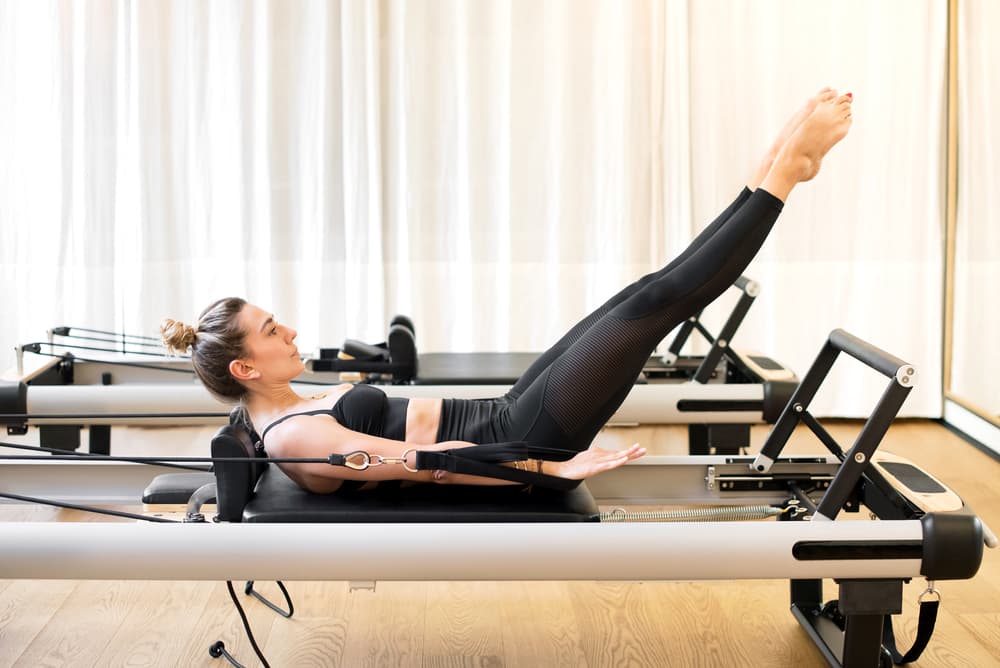Choosing between mat Pilates and a reformer may be difficult, especially if you’re a beginner. To help, let’s compare the two and see which one suits you best.
I’ll be defining both Pilates forms first, then identify relevant factors that highlight their differences, benefits and downsides.
What is Mat Pilates?
As the name implies, this form requires a mat laid on a flat surface to perform various Pilates exercises.
Unlike a reformer with adjustable springs, bars and straps for resistance, mat work uses your body weight.
Most people think that this type is beginner level to progress to Pilates reformer exercises.
But once you try it, you’ll realise that a mat class is different and challenging.
You can complement the mat with resistance bands, exercise balls or a magic circle if you like.
This way, you can get a full-body workout, targeting your pelvic floor, back and abdominal muscles.
What is a Pilates Reformer?
Mat Pilates needs a flat floor surface. On the other hand, reformer exercises require an elevated surface – a bed-like frame with a sliding carriage, to be exact.
Don’t be intimidated by the springs and pulleys attached, though.
Joseph Pilates designed it this way as, in the past, Pilates was used to rehabilitate wounded, bed-ridden soldiers.
The ropes and pulleys are there for resistance training.
Like mat work, a reformer also targets similar muscle groups, with a particular focus on your core and spine.
Once you try both mat and reformer Pilates, you’ll notice that a reformer allows more fluid movements.
Reformer vs Mat Pilates: What’s the Difference?
You need two different pieces of equipment to perform both Pilates forms. However, they have more distinct qualities that make them more fitting to specific individuals.
Here are some of them.

Convenience
Pilates mat classes are practically a staple in most fitness centres and health clubs. Why? Because mat work only needs a mat and supportive surface.
Once you learn the basic moves, you can easily do it at home alone or in a group setting.
Compared with a reformer, a mat is not expensive and does not require a spacious gym, either.
As for reformers, you will have to spend on classes or costly and bulky equipment.
Your mat is also a versatile piece of equipment that you can use for Pilates and yoga.
Unlike a heavy bed-like reformer, a mat is easier to pack, carry and roll out anywhere, too.
If it’s your first time trying Pilates, you will find mat work less intimidating than a reformer, too.
It’s because the set-up is more familiar and not as complicated to figure out.
Mat Pilates is undoubtedly more convenient, accessible and portable than the reformer type.
For some first-timers, it’s also a practical option, allowing them to try Pilates without too much investment.
Exercise Difficulty
Are you up for challenging workouts? If yes, Pilates with a mat is better for you than a reformer.
You see, a reformer has ropes and bars that you can hold onto for balance and coordination. Mat work does not offer that level of assistance.
With this Pilates type, your muscles, joint and weight are the exercise machine. That said, a mat workout would naturally be more physically demanding.
Mat Pilates requires more strength, focus and flexibility to execute moves successfully.
However, intense exercises are not for everyone. Some are easily discouraged when moves need lots of force and stamina.
In that case, reformer Pilates is worth considering. This piece of exercise equipment has attachments for resistance that, in turn, send you feedback.
Such input helps you keep your body stable. Users who need to improve their balance and strength will find a reformer more forgiving.
A Pilates reformer also suits people with injuries or limited range of motion.
The assistance this piece of equipment provides should allow them to move without straining the body too much.

Exercise Variety
As I’ve mentioned, a reformer has pulleys and ropes that allow users with a disability to exercise more safely.
People with a knee injury or scoliosis, for example, will likely find reformer exercises more doable than mat work.
While mat Pilates is physically more accessible, a reformer is more usable for individuals of varying fitness levels.
But reformer Pilates attachments are not only for assisting users with a limited range of movement.
These also let you perform exercise variations beyond what you can do on a mat.
Adjusting the springs on your reformer, for instance, lets you shift from stabilising to muscle-building exercises.
Moreover, Pilates reformer accessories, like the short box and tower, let you be in various body positions.
A reformer will not disappoint for sure when it comes to workout diversity.
Weight Loss and Muscle Building
We have different reasons why we choose to do Pilates. Some do it for building strength. Others use it to improve balance and flexibility.
But when your fitness goal is to burn calories and build muscle mass, a reformer workout is best.
That’s because the resistance from the reformer lets you adjust the intensity of your exercises.
Its effect, of course, will not be the same as weightlifting or bench workouts. Still, it encourages progressive muscle strengthening and growth.
A reformer is also a better option to build muscles with a lower risk of overuse and injury.
Increasing your muscle tone naturally helps with your weight loss plan. But what makes a reformer better in burning calories than mat Pilates is its jumpboard.
With it, you can perform cardio and plyometric exercises without stressing your joints.
This accessory also lets you do arm and leg movements that quickly boost the heart rate.
The effects of exercise variety and resistance of reformer Pilates make it possible to see visible results faster, too.

Reformer vs Mat Pilates: Verdict
After comparing the two, it’s clear that both have their pros and cons.
And it is surprising how Pilates can vary with a simple switch of equipment.
For me, I believe the reformer Pilates is better than a mat.
While I need to find room for this relatively expensive equipment, its many benefits outweigh the cost.
But then again, it’s all a matter of preference and fitness needs.
If you like getting toned muscles using portable equipment, mat sessions will surely make you a happy camper!
Do you think a Pilates reformer is for you, too? Check out my buying guide to learn more.
- Foldable vs Traditional Reformers: Which One’s Right for You? - 2 July 2025
- Elliptical Cross Trainer vs Exercise Bike: Which is Better? - 24 June 2025
- How Do the Different Massage Gun Attachments Work? - 23 June 2025
